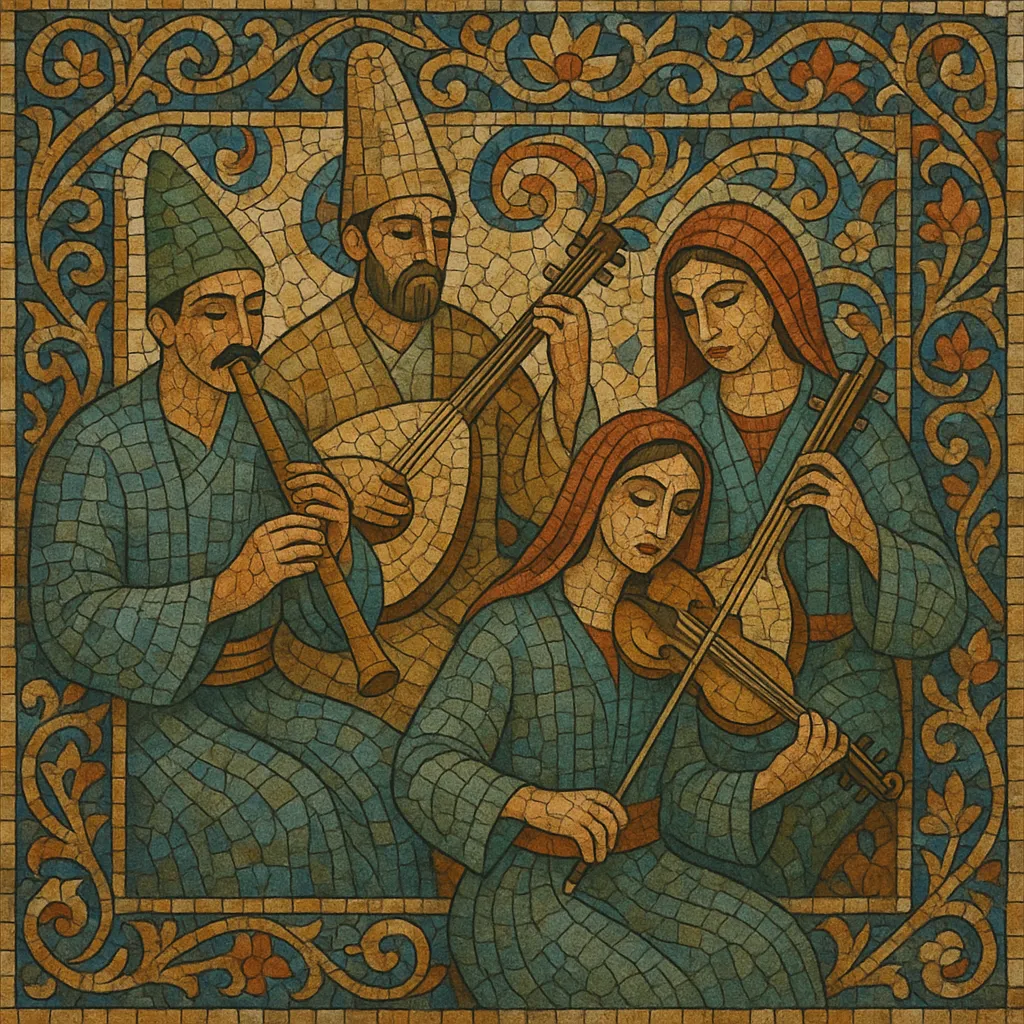Turkish classical (Ottoman/Turkish art music) is a refined modal art tradition centered on the makam (scale/melodic behavior) system and cyclical rhythms called usul. It developed in the Ottoman court, Mevlevi lodges, and urban salons, using an intimate chamber instrumentation (ney, tanbur, ud, kemençe, kanun, keman) and highly ornamented vocal lines.
Compositions follow characteristic forms such as peşrev and saz semaisi (instrumental), as well as vocal forms like beste, kar, semai, yürük semai, and the later şarkı. Improvisation (taksim) introduces and connects sections, exploring the seyir (melodic path) of the chosen makam with nuanced microtonal inflections.
Its aesthetic emphasizes subtle emotion, controlled ornamentation, and measured development, with repertoire spanning sacred (Mevlevi ayin) and secular works. The tradition balances composed structure and spontaneous improvisation, cultivated through the meşk (master–apprentice) pedagogy.
Ottoman urban and courtly music coalesced from interactions among Persian, Arabic, Byzantine, Armenian, Greek, and Anatolian traditions. By the 1600s, a distinctive makam-based system and repertoire were firmly taking shape in imperial centers such as Istanbul and Edirne. The Mevlevi Sufi lodges provided an additional sacred context, nurturing large-scale ayin (whirling ceremony) cycles.
Key composer-scholars helped systematize the art. Prince Dimitrie Cantemir authored an early 18th‑century treatise and notated many works. Buhurizade Mustafa Itri and later Hammamizade İsmail Dede Efendi wrote foundational vocal and Mevlevi pieces. In the early 19th century, Hampartsum Limonciyan introduced the Hamparsum notation widely used in Ottoman circles, aiding the preservation of repertoire.
Salon culture, court patronage, and Sufi institutions sustained the tradition. Masters like Tanburi Cemil Bey expanded instrumental technique and recorded early examples, while Hacı Arif Bey shaped the şarkı (art song) form. After the Republic’s founding (1923), western staff notation and conservatory training spread; theorists like Rauf Yekta, Hüseyin Sadettin Arel, and Suphi Ezgi codified pitch and rhythm systems (Arel–Ezgi–Uzdilek), standardizing microtonal intervals and usul.
Radio (TRT) and conservatories institutionalized the style, while archival reissues and scholarly editions broadened access. Virtuosos such as Niyazi Sayın and Necdet Yaşar renewed instrumental lineages; vocalists like Münir Nurettin Selçuk bridged classical aesthetics and modern audiences. Today the tradition persists in concert halls, Sufi contexts, and university programs, with ongoing debates on historical intonation, performance practice, and ornamentation.
Select a makam (e.g., Rast, Hüseynî, Hicaz, Uşşâk, Segâh, Nihâvend). Study its seyir (melodic path), focal tones, typical ascending/descending behavior, cadential pitches, and characteristic motives. Plan modulation points to related makams if desired.
Decide on a cyclical rhythmic pattern (usul) such as Sofyan (4/4), Düyek (8/8), Aksak (9/8), Semai (6/8), or Devr‑i Kebir (28/4). Match it to a form: an instrumental peşrev (with hane + teslim structure), saz semaisi (typically ending with a 10/8 semai segment), or a vocal beste/semai/şarkı. Consider including a free‑meter taksim intro.
Use appropriate microtones (commas/koma) per the Arel–Ezgi–Uzdilek or historical intonation; approach cadences (karar) with ornamented turns, grace notes, and subtle slides. Maintain clear phrase architecture and allow space for breath and expressive timing (usul should feel cyclic yet flexible when appropriate).
Score for a small ensemble: ney (end‑blown flute), tanbur (long‑neck lute), ud (fretless lute), kanun (zither), kemençe or violin, and light percussion (bendir, kudüm) when idiomatic. For vocal works, match tessitura and diction to the form and include a chorus (fasıl ensemble) if desired.
Open with a taksim to introduce the makam’s core colors; insert short improvisatory bridges between composed sections. Modulate to related makams sparingly and return to the principal makam for decisive cadences. End with a recognizable teslim or a poised vocal cadence.
Follow the meşk tradition: learn by ear from authoritative recordings and teachers, internalize usul by counting and bodily feel, and refine articulation, timbre, and intonation through careful listening. Prioritize expressive control and clarity over virtuosity for its own sake.


